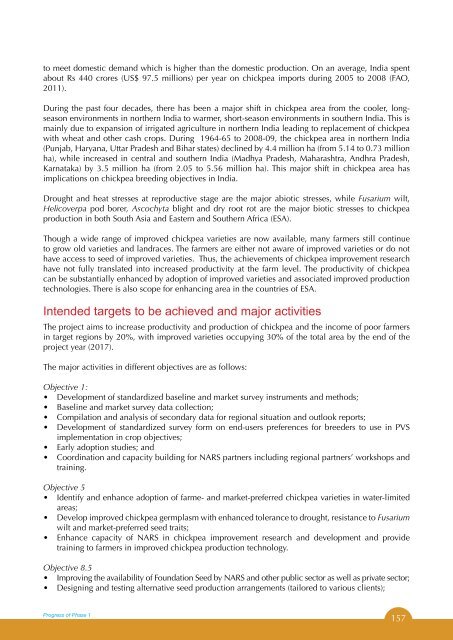Final version of Tropical Legumes II Project Report for Phase 1 - icrisat
Final version of Tropical Legumes II Project Report for Phase 1 - icrisat
Final version of Tropical Legumes II Project Report for Phase 1 - icrisat
You also want an ePaper? Increase the reach of your titles
YUMPU automatically turns print PDFs into web optimized ePapers that Google loves.
to meet domestic demand which is higher than the domestic production. On an average, India spent<br />
about Rs 440 crores (US$ 97.5 millions) per year on chickpea imports during 2005 to 2008 (FAO,<br />
2011).<br />
During the past four decades, there has been a major shift in chickpea area from the cooler, longseason<br />
environments in northern India to warmer, short-season environments in southern India. This is<br />
mainly due to expansion <strong>of</strong> irrigated agriculture in northern India leading to replacement <strong>of</strong> chickpea<br />
with wheat and other cash crops. During 1964-65 to 2008-09, the chickpea area in northern India<br />
(Punjab, Haryana, Uttar Pradesh and Bihar states) declined by 4.4 million ha (from 5.14 to 0.73 million<br />
ha), while increased in central and southern India (Madhya Pradesh, Maharashtra, Andhra Pradesh,<br />
Karnataka) by 3.5 million ha (from 2.05 to 5.56 million ha). This major shift in chickpea area has<br />
implications on chickpea breeding objectives in India.<br />
Drought and heat stresses at reproductive stage are the major abiotic stresses, while Fusarium wilt,<br />
Helicoverpa pod borer, Ascochyta blight and dry root rot are the major biotic stresses to chickpea<br />
production in both South Asia and Eastern and Southern Africa (ESA).<br />
Though a wide range <strong>of</strong> improved chickpea varieties are now available, many farmers still continue<br />
to grow old varieties and landraces. The farmers are either not aware <strong>of</strong> improved varieties or do not<br />
have access to seed <strong>of</strong> improved varieties. Thus, the achievements <strong>of</strong> chickpea improvement research<br />
have not fully translated into increased productivity at the farm level. The productivity <strong>of</strong> chickpea<br />
can be substantially enhanced by adoption <strong>of</strong> improved varieties and associated improved production<br />
technologies. There is also scope <strong>for</strong> enhancing area in the countries <strong>of</strong> ESA.<br />
Intended targets to be achieved and major activities<br />
The project aims to increase productivity and production <strong>of</strong> chickpea and the income <strong>of</strong> poor farmers<br />
in target regions by 20%, with improved varieties occupying 30% <strong>of</strong> the total area by the end <strong>of</strong> the<br />
project year (2017).<br />
The major activities in different objectives are as follows:<br />
Objective 1:<br />
• Development <strong>of</strong> standardized baseline and market survey instruments and methods;<br />
• Baseline and market survey data collection;<br />
• Compilation and analysis <strong>of</strong> secondary data <strong>for</strong> regional situation and outlook reports;<br />
• Development <strong>of</strong> standardized survey <strong>for</strong>m on end-users preferences <strong>for</strong> breeders to use in PVS<br />
implementation in crop objectives;<br />
• Early adoption studies; and<br />
• Coordination and capacity building <strong>for</strong> NARS partners including regional partners’ workshops and<br />
training.<br />
Objective 5<br />
• Identify and enhance adoption <strong>of</strong> farme- and market-preferred chickpea varieties in water-limited<br />
areas;<br />
• Develop improved chickpea germplasm with enhanced tolerance to drought, resistance to Fusarium<br />
wilt and market-preferred seed traits;<br />
• Enhance capacity <strong>of</strong> NARS in chickpea improvement research and development and provide<br />
training to farmers in improved chickpea production technology.<br />
Objective 8.5<br />
• Improving the availability <strong>of</strong> Foundation Seed by NARS and other public sector as well as private sector;<br />
• Designing and testing alternative seed production arrangements (tailored to various clients);<br />
Progress <strong>of</strong> <strong>Phase</strong> 1<br />
157
















